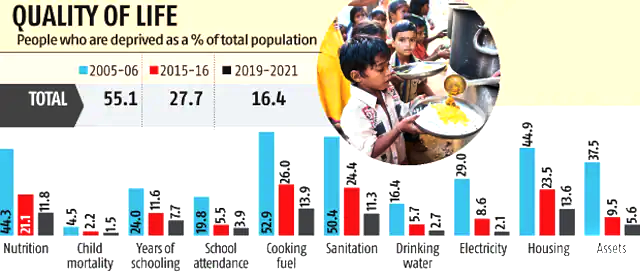Context
-
The Global Multidimensional Poverty Index 2022 recently released by the United Nations Development Programme (UNDP) and the Oxford Poverty and Human Development Initiative (OPHI) at the University of Oxford.
Key Findings of the Global Multidimensional Poverty Index 2022
- Around 415 million people in India climbed out of poverty between 2005-06 and 2019-21, with the incidence of poverty falling from 55 per cent to just over 16 per cent over this period.

- Despite the significant reductions, however, the largest number of poor people in the world — 228.9 million — lived in India in 2020.
- India’s MPI value and incidence of poverty were both more than halved.
- The MPI value fell from 0.283 in 2005-2006 to 0.122 in 2015-2016 to 0.069 in 2019-2021.
- The incidence of poverty fell from 55.1 per cent in 2005-2006 to 27.7 per cent in 2015-2016 to 16.4 per cent in 2015-2016.
- The incidence of poverty fell from 36.6 per cent in 2015-2016 to 21.2 per cent in 2019-2021 in rural areas and from 9.0 per cent to 5.5 per cent in urban areas.
- The drop in poverty demonstrates that the “Sustainable Development Goal target 1.2 of reducing at least by half the proportion of men, women and children of all ages living in poverty in all its dimensions according to national definitions by 2030 is possible to achieve—and at scale.
- The poorest states in the country reduced poverty the fastest and deprivations in all indicators fell significantly among poor people. Poverty among children fell faster in absolute terms, although India still has the highest number of poor children in the world.
- More than one in five children in India are poor (21.8 per cent, or 97 million) compared with around one in seven adults (13.9 per cent).
- The most common profile, affecting 3.9 percent of poor people, includes deprivations in four indicators: nutrition, cooking fuel, sanitation, and housing.
- More than 45.5 million poor people are deprived in only these four indicators.
- Of those people, 34.4 million live in India, 2.1 million in Bangladesh and 1.9 million in Pakistan—making this a “predominantly South Asian profile”—said the MPI report.
- India’s progress shows that this goal (Sustainable Development Goal 1.2 to reduce poverty) is feasible, even at a large scale, adding that India shows significant reduction in all 10 indicators.
- The 2019-2021 data show that about 4.2% of the population live in severe poverty and about 18.7% people, roughly the same proportion as in 2015-2016, are vulnerable to poverty.
Back2Basics
- The Global Multidimensional Poverty Index is a key international resource that measures acute multidimensional poverty across more than 100 developing countries and was first launched in 2010 by the OPHI and the Human Development Report Office of the UNDP.
- The MPI monitors deprivations in 10 indicators spanning health, education and standard of living and includes both incidence as well as intensity of poverty.
Reference:
Visit Abhiyan PEDIA (One of the Most Followed / Recommended) for UPSC Revisions: Click Here
IAS Abhiyan is now on Telegram: Click on the Below link to Join our Channels to stay Updated
IAS Abhiyan Official: Click Here to Join
For UPSC Mains Value Edition (Facts, Quotes, Best Practices, Case Studies): Click Here to Join
